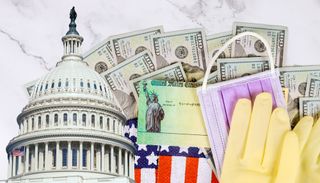How to Set Up Direct Deposit for Stimulus Check With Irs
Stimulus check: IRS paying out $4.3 billion in new checks

The latest batch of stimulus checks is hitting the bank accounts of nearly 2 million Americans this week, with funds going to recent tax filers and those eligible for new or larger "plus-up" payments.
Since mid-March, the IRS has processed seven weekly rounds of checks provided by the Biden administration's American Rescue Plan — the third stimulus relief package since the beginning of the pandemic.
- Fourth stimulus check update: Possible amount and timeline
- Stimulus check status: How to track down your payment now
- Plus: Biden's new stimulus bill — how you could get more money
This latest batch, officially released yesterday (April 28), includes payments for 1.2 million people whose 2020 tax returns were recently processed and who previously didn't have enough information on file to qualify for a stimulus check.
More than 730,000 people are receiving "plus-up" payments, provided to taxpayers who made significantly less in 2020 than they did in 2019.
As a reminder, the American Rescue Plan provided $1,400 checks for individuals earning up to $75,000 per year and couples making $150,000 per year. The same amount goes to child and adult dependents.
If you earn up to $80,000 or $160,000 per year, respectively, you're eligible for a prorated payment.
The IRS is sending out checks and "plus-ups" every Wednesday as it processes 2020 tax returns. If your initial stimulus check 3, based on your 2019 return, was too small or if you got married or added a dependent in 2020, you could receive a supplemental payment after you file for 2020.
While income-tax returns aren't due until May 17 for most filers, the sooner you submit yours, the sooner you'll get the stimulus relief you're owed.
How to claim the Recovery Rebate Credit
Another reason to finish your 2020 tax return now: You may be able to claim a credit for money you missed with stimulus checks 1 and 2.
The Recovery Rebate Credit, found on Line 30 of Form 1040 or 1040-SR, goes to taxpayers who made less in 2020 than they did in 2019 — enough less that they would have qualified for larger direct payments had the IRS used their 2020 return instead.
The credit is being sent out as a tax refund or applied toward taxes you owe for the year. There are a few simple steps for determining your eligibility and claiming the credit on your return. If you've already filed and think you should have claimed the credit, you can submit an amended return.
In fact, the IRS is urging even those people who don't normally file income-tax returns, such as those living on disability payments, pensions or Social Security, or persons who are homeless or who have little or no income at all, to file 2020 tax returns.
"The IRS needs information from people who don't usually file a tax return — even if they did not have any income last year or their income was not large enough to require them to file," the agency said in a blog post earlier this month. "The only way for the agency to have that information is for people to file a basic 2020 tax return with the IRS."

Emily Long is a Utah-based freelance writer who covers consumer technology, privacy and personal finance for Tom's Guide. She has been reporting and writing for nearly 10 years, and her work has appeared in Wirecutter, Lifehacker, NBC BETTER and CN Traveler, among others. When she's not working, you can find her trail running, teaching and practicing yoga, or studying for grad school — all fueled by coffee, obviously.
How to Set Up Direct Deposit for Stimulus Check With Irs
Source: https://www.tomsguide.com/news/irs-pays-out-4-3-billion
0 Response to "How to Set Up Direct Deposit for Stimulus Check With Irs"
Post a Comment